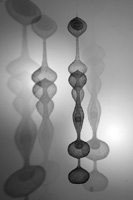home | metro silicon valley index | the arts | visual arts | review

Hung With Care: Asawa's 'Untitled' (S. 250) stretches more than 11 feet from its ceiling wire.
Wired
Ruth Asawa's sculptures create volumes of meaning from lines in space
By Michael S. Gant
THE INTRICATE woven-wire sculptures of Bay Area artist Ruth Asawa quiver in conceptual space. At times, they look like solidified magnifications of microscopic creatures—blobs of biological matter dangling from the ceiling. Sometimes, though, they appear more like constructs of pure logic, artistic equations that define lines moving through space to create volumetric forms.
Asawa's sculptures, now on view at San Francisco's de Young Museum (the San Jose Museum of Art has some samples in its permanent collection, displayed in the lobby), evolve to complexity from simple operations. Asawa takes long strands of wire—copper, iron, galvanized bronze—and makes e-shaped loops, as if she were crocheting. The loops, usually single, but sometimes double and even triple, grow into various spheres and ovoids connected by narrow necks.
In her first variations, from the early 1950s, these bulb shapes resemble droplets in a narrow stream of water, plopping from a slow-dripping faucet. Gravity is ready to absorb the pieces, but the rigid wire material holds them frozen in space. Later, the spheres start to fold back on themselves. Magically, the wire forms interpenetrate each other, making fluid transitions from outside to inside and back again. In her masterful Untitled (S. 250), from 1955, a series of spheres—squashed, elongated, flattened—depend from the ceiling for more than 11 feet, connected by tubular ligaments, with forms nesting within forms. No matter how hard you look, it is impossible to figure out exactly how this interpenetration takes place; it is as if the artist were working outside and inside at the same time. Dark and light alternate where shapes envelop other shapes, creating overlapping mesh patterns. Different wires produce subtle shifts from shiny gray to glowing reds. The whole effect is heighten by judicious ceiling spots; the light casts pale gray shadow versions of the pieces on the walls.
Asawa, the daughter of Japanese immigrants to California, was born in 1926, and ended up, with her family, in the an internment camp during World War II. After the war, thwarted in her desire to become a teacher by lingering racism, she enrolled at the experimental Black Mountain College in North Carolina. Her major influences there were Bauhaus teacher Josef Albers and all-round eccentric genius Buckminster Fuller. From these two devotees of pure form, Asawa learned how to use economical means to achieve complex results; in that way, her pieces express the same spare elegance as Fuller's geodesic domes. The show includes some of the classroom exercises Asawa did for Albers, among them pages of spiral patterns known as meanders. By replicating these meanders in various colors and line density, highly evolved rhythms of figure and ground could be created.
On a trip to Mexico, Asawa learned how to weave baskets from wire; the craft was a revelation that informed her best work for decades. As she wrote (the quote is from the excellent catalog), "It's an amazing technique. All my wire sculptures are made from the same loop. And there's only one way to do it. The idea is to do it simply, and you end up with a shape. That shape comes out working with the wire. ... It's like a drawing in space."
When Asawa started showing her wire sculptures in the 1950s, a certain critical disdain reared its head to sniff that she was practicing a folk craft—a woman's craft at that—rather than delivering high art. But the de Young show disabuses us of that notion. Asawa's basic process couldn't be simpler, but she applies it to a profusion of seductive shapes. Asawa is most identified with hanging blobular sculptures, but the exhibit also contains examples of her tied-wire trees. Starting with a tight bundle of thin wires, Aswan divides and ties off the strands at regular nodes that act like forking branches. The half-again, half-again operation continues until only single wires remain, culminating in pointy strands like bare twigs. Some of these sculptures sit on wooden bases like bronzed bonsai; others grow down from the ceiling. A few fold back on themselves in symmetrical mandala patterns. In a further exploration of her material, Asawa has the ends of some of her "branches" electroplated, a process that creates thick, rough-textured nubbins at the ends—the effect is that of a spring tree in early bud.
The Sculpture of Ruth Asawa: Contours in the Air shows through Jan. 28 at the de Young Museum, Golden Gate Park, San Francisco. (415.863.3330) An extensive catalog with essays is published by the University of California Press.
Send a letter to the editor about this story.
|
|
|
|
|
|